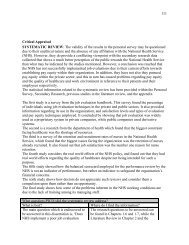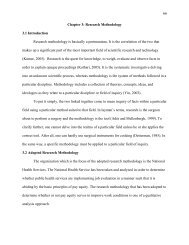13 Chapter 2: Critical Literature Review 2.1 ... - Dissertation
13 Chapter 2: Critical Literature Review 2.1 ... - Dissertation
13 Chapter 2: Critical Literature Review 2.1 ... - Dissertation
You also want an ePaper? Increase the reach of your titles
YUMPU automatically turns print PDFs into web optimized ePapers that Google loves.
192.4.2 Analytical SchemesAnalytical schemes are divided into two fundamental methods: the factor comparison andthe point method. The factor comparison is a quantitative method that employs the use of thementioned compensable factors by ranking each one in order of significance in relation to the jobat hand. Once each aspect of the job has been ranked, the factors are allotted fiscal meritdepending on their importance in the concerned job. However, it has been seen as a cumbersomeprocess since assigning the financial values to these factors in order to translate their worth intoactual pay equity can be time consuming (Thorpe and Homan, 2000, p.238).In the case of the point method, it has been said to be the most widely used method toevaluate jobs. It is based on the same principles as the factor method, but it differs by using theconcept of points rather than revenue in order to gauge the importance of the aforementionedcompensable factors. A range of points may be assigned to each individual factor, whichprovides the company the importance of each factor in comparison to another. When the pointsof these factors are allocated to the aforementioned job, it can be used to arrive at a conclusionregarding the overall hierarchy of the job in question. Once such a hierarchy has beenestablished, the financial value of the job can be ascertained within the chain of command(International Labour Office, 1986, p.80; Solomon, 1997, p.88-89).An example of this would entail paying more to those above the chain rather than below.This, as previously mentioned, is the most commonly used job evaluation scheme inorganizations today. However, although its use provides a secure system over time, it has theweakness of having high administrative costs and it does not prove itself open to practical usewithin smaller organizations (Berger, 2008, pp.100-104).





